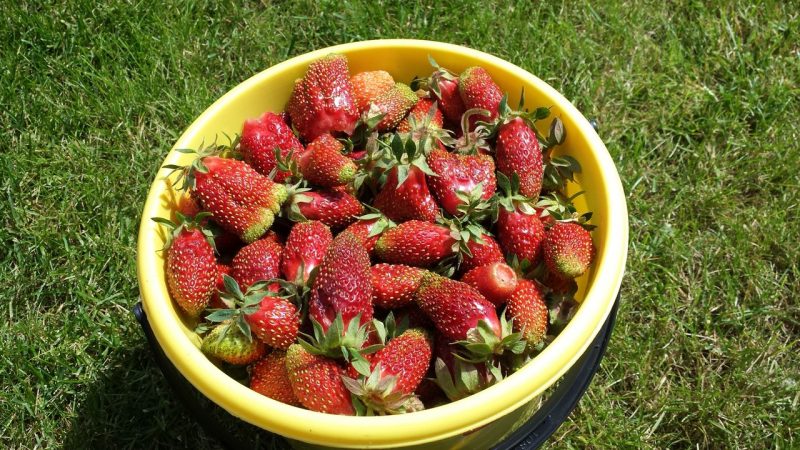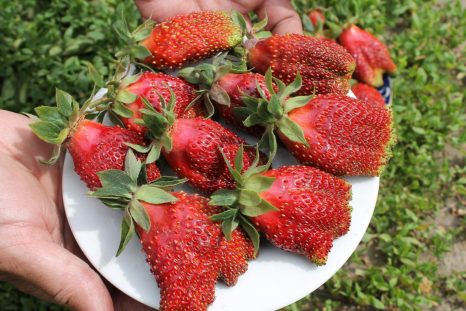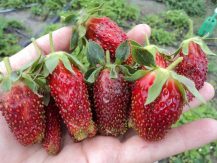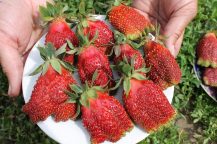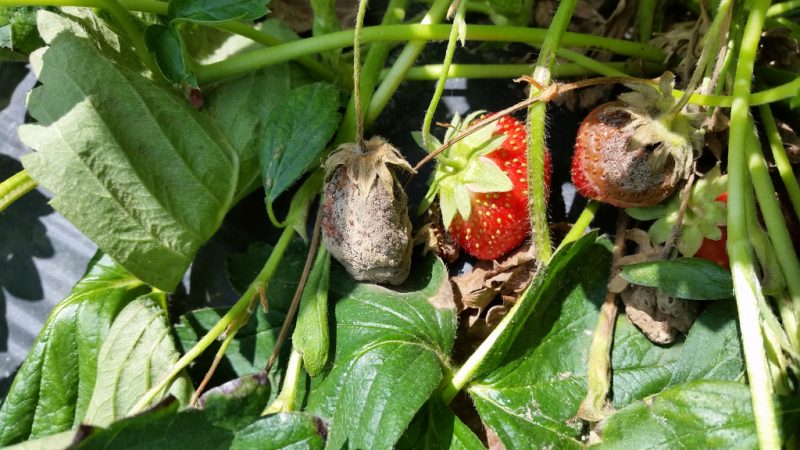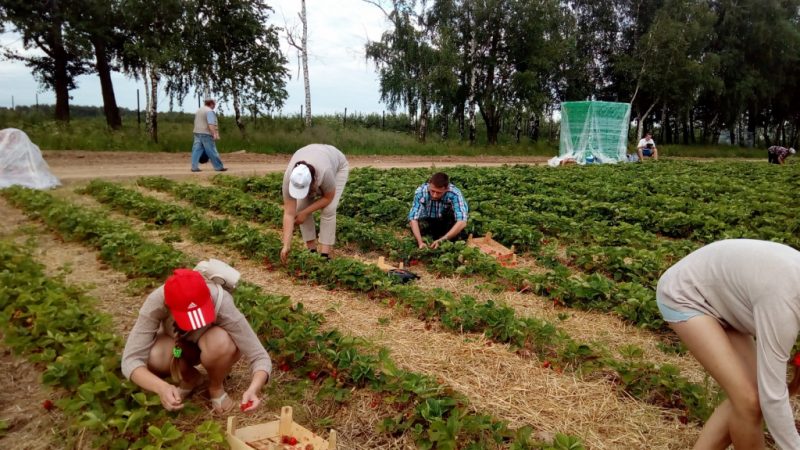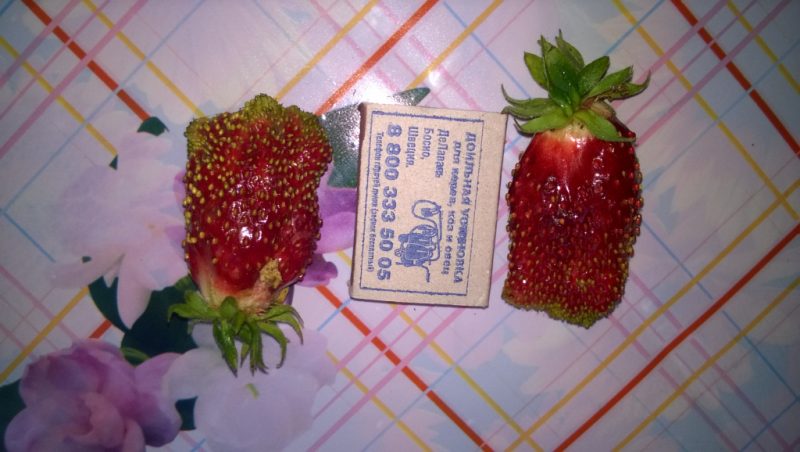Strawberries - a natural sweet treat, loved not only fresh, but also as jams, preserves. To date, many varieties have been developed that have established themselves as highly productive and easy to grow. But among this abundance of fruits of the successful work of breeders, a promising hybrid, the strawberry "Kupchikha," cannot be overlooked.
Material Content:
Description and features of the variety
An innovative variety of domestic selection with the promising name “Merchant” was obtained in 2014 by breeder S.D. Aitzhanova as a result of crossing wild strawberry and musk. For this reason, culture is often called a dredger.
The mid-ripening variety is represented by rather high bushes formed by strong shoots covered with long-chashed wrinkled leaves of a saturated green color. During flowering, a large number of bisexual flowers are noted, under which the foliage is practically not visible. Over time, in place of flowers, dark red trident shaped fruits form. The average weight of fairly large berries varies between 25-35 g. Due to the dense structure of the pulp, a variety with excellent aroma is grown on an industrial scale, excellently transporting.
Among the indisputable advantages of the garden strawberry "Merchant" stand out:
- consistently high productivity regardless of the weather (135 c / ha);
- high appreciation of the taste of fairly large fruits;
- good commercial quality;
- frost and heat resistance;
- resistance to shedding and harmful organisms;
- unpretentiousness in leaving;
- shade tolerance.
Among the shortcomings, according to the description of the variety, it is possible to distinguish, perhaps, irreplaceability of strawberries with a single ripening of the crop during the growing season.
Growing seedlings from seeds
Strawberry seeds do not differ in good germination, but thanks to the time-consuming method of cultivation, the gardener will save money and protect the variety from genetic diseases transmitted by the vegetative method of propagation.
The scheme for growing seedlings involves the following actions:
- Disinfected containers for seedlings at the end of winter are filled with a mixture of turf land, sand and peat in a ratio of 2: 1: 1.
- Seeds purchased in a specialized store are distributed on the substrate and sprinkled with a 1 cm soil layer.
- Crops are covered with glass and kept in a warm, shaded room. where systematically moisturized.
- After 20-25 days, when the first seedlings appear, the capacity is transferred to the source of scattered light.
- After the appearance of 2-3 real leaves, seedlings dive into separate containers, from which they are planted in open ground at the end of spring.
To accelerate the germination of seeds, you can soak them for a day in a growth stimulator or for three days in warm water.
Technology of planting plants in the ground
A hybrid of strawberries and strawberries can be planted both in a well-lit place and in partial shade. The optimal time for planting is considered two periods - the end of spring-beginning of summer and the end of summer-beginning of autumn. High yields can be obtained only in areas with fertile soil, which is prepared in advance. Under digging, organic fertilizers (humus, compost) and mineral fertilizers (nitroammophoska, superphosphate) are introduced.
Step-by-step landing scheme:
- Wells with sizes corresponding to the root system of seedlings are dug up on the site.
- Mounds are made at the bottom, on which seedlings are set with spread roots.
- The bushes are sprinkled with earth in such a way that the heart remains at ground level.
- Trunk circles are compacted so that no air holes remain around the roots, they are watered and the drying field is mulched.
When planting strawberries “Tradeswoman”, it is recommended to maintain a distance of 30 cm between plants and 50 cm between rows.
Rules for the care of strawberries Tradeswoman
The variety is quite unpretentious, but in order to realize its potential it needs to comply with the agrotechnical regulation of culture cultivation:
- watering - it is recommended that plants organize moderate drip irrigation, which will prevent excessive soil waterlogging;
- soil cultivation - to obtain the maximum possible row spacing yield, they are systematically cultivated with the simultaneous removal of weed vegetation and mulching at the end of all procedures;
- top dressing - it is necessary to enrich the soil systematically, but sparingly, not forgetting after applying mineral fertilizer to organize abundant watering, which prevents burns on the aerial parts of strawberries.
The variety is frost-resistant and does not need special shelter. It is good enough to mulch the landing.
Breeding methods
Propagation of strawberries "Tradeswoman" is carried out mainly by the vegetative method, which retains varietal characteristics and is simple to perform. The generative method of propagation is very laborious, and not always as a result of its implementation, the gardener receives the variety that he wanted to have on his site.
At the end of spring, the largest, most productive bush is selected. He leaves several powerful mustaches with first-order sockets that are pinned to the ground. The remaining antennae are removed so that all the forces of the mother plant are directed to rooting. When 5 leaflets are formed on the rosettes, indicating successful root formation, the plants are separated and planted in the prepared place.
Pest and Disease Control
Breeders declared the variety's high resistance to pests and diseases, as evidenced by its lack of susceptibility to fungal infections, provoking the development of such common and dangerous diseases as powdery mildew and gray rot.
In general, on plantings, signs of late blight can be noted, the development of which is associated with disturbances in crop rotation. You can not plant strawberries after solanaceous and pumpkin crops. In case this happened, a transplant is required.
Harvesting and Aftercare
Beginning of fruiting occurs at the end of June, when a harvest occurs as the berries ripen. As a rule, this happens in 2 stages. Strawberries are not kept fresh for a short time, therefore, with a large number of them, fruit processing is required. Thanks to good transportability, the crop can be used for sale in stores.
When harvesting is completed, the shoots should be shortened and the mustache removed. In mid-autumn, the beds are freed from dead plant debris and covered with a thick layer of mulch, which will save the plantings of the frost-resistant variety from winter cold.
How many years does the strawberry merchant produce fruit?
Despite the fact that fruiting is noted for 5 years of cultivation, it is recommended that the Kupchikha strawberry variety be transplanted to another site after 4 years. This avoids a decrease in productivity due to soil depletion and the accumulation of infection in it, as well as a significant supply of other harmful organisms.
Strawberry "Merchant" in the short time of its existence has won the love of many gardeners and farmers who give it preference because of its unpretentiousness, high productivity, high taste and marketability.



